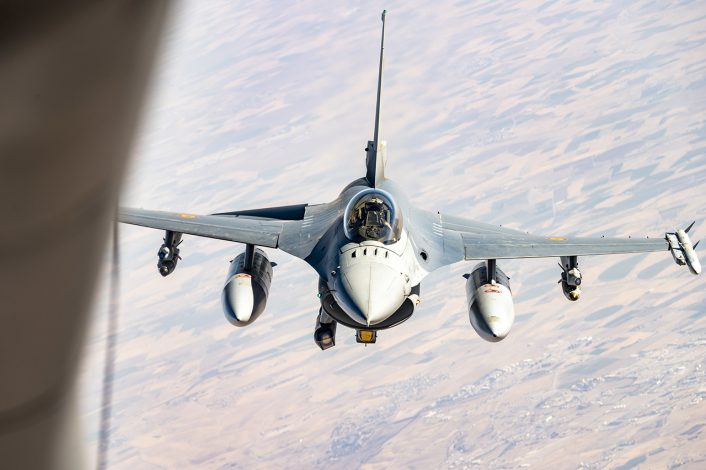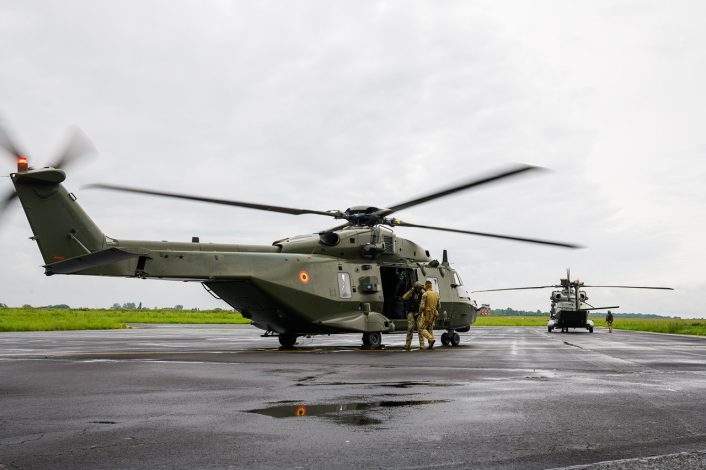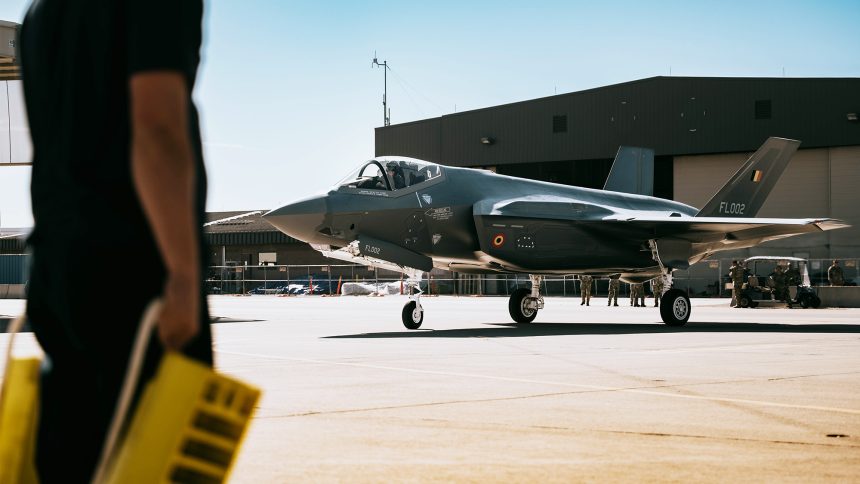Belgium will shore up its commitment to the F-35 with a follow-on order for more jets and for cruise missiles to arm them, while also seeking an expanded role in the European FCAS programme.
Plans which have circulated since early July were formally approved by the Belgian Government and announced by Minister of Defence Theo Francken last week. The headline of the new vision for Belgian defence is a follow-on order for 11 additional F-35A Lightning II aircraft, bringing Belgium’s planned fleet from 34 jets to 45.
No F-35s have yet been delivered to Belgian soil, but eight airframes are in the hands of Belgian Air Component pilots training on their new aircraft in the United States. The first F-35s to be based in Belgium are expected to make the journey across the Atlantic later this year. Francken says that the extra batch of 11 jets will be assembled in Europe at the Final Assembly and Check Out (FACO) facility in Cameri, Italy.
First 🇧🇪 pilots complete F-35 training course in 🇺🇸
Another important milestone for the 🇧🇪 Air Force as they transition to the fifth generation platform. The first F-35 is expected in Florennes later this year, increasing Allied capabilities, deterrence & defence
📸 Moors M pic.twitter.com/7omqRvSjlb
— NATO Air Command (@NATO_AIRCOM) July 15, 2025
For some years it has been reported that in order to provide the expected level of capability to NATO’s overall order of battle, Belgium would need at least 55 deployable combat aircraft. The nation’s existing fleet of F-16s (including both F-16AM and twin-seat F-16BM models) numbers around 54 aircraft. Rumors about a potential order for 21 more F-35s over the initial 34 have circulated previously – it is very possible that an extra follow-on order for 10 more aircraft may come at some stage in the future.

Belgium selected the F-35 as its new fighter in 2018, winning out over the Eurofighter Typhoon on financial grounds thanks to the scale of production. An additional, and perhaps even more important factor, is that the Typhoon is not certified for the delivery of B61 nuclear weapons, which Belgium hosts under the NATO Nuclear Sharing programme. A similar circumstance applied to Germany, who after many years of deliberation also opted to buy a force of F-35s to operate alongside its sizable Typhoon fleet.
Upon delivery of a sufficient number of F-35s, Belgium plans to begin transferring its retiring F-16s to the Ukrainian Air Force. Belgium pledged its jets in 2024, with up to 30 to be delivered to Ukraine by 2028.
As well as approving additional F-35s, the Government also green lit a proposal to order the Kongsberg Joint Strike Missile (JSM). This will be Belgium’s first known foray into the world of air-launched cruise missiles, with the current F-16 fleet relying only on Paveway and Joint Direct Attack Munition (JDAM) equipped bombs as well as the GBU-39 Small Diameter Bomb (SDB). Defence Minister Francken previously described the addition of JSM as a “game changer” for national deterrence and operational autonomy.
The first test of a Joint Strike Missile (JSM) from an F-35 recently took place @EdwardsAFB.
This successful start to jettison testing keeps the JSM test program on track to deliver increased long-range strike capabilities to the @Luftforsvaret. pic.twitter.com/ucIkZ5oOnF
— F-35 Lightning II (@thef35) April 15, 2021
The JSM is a relatively small cruise missile in the 500 kg weight class, though importantly its size means the missile is able to fit within the F-35A’s internal weapon bays. It is derived from the Naval Strike Missile (NSM) which now equips many NATO warships and is intended to be fitted on Belgium’s new anti-submarine warfare frigates. The missile touts a maximum range between 500 and 600 kilometres at high subsonic speeds, and a low radar cross-section design reduces vulnerability to air defence weaponry.
Eyes on FCAS
Looking to the future, Belgium wants to get further on board with the joint Future Combat Air System (FCAS) programme being led by France, Germany, and Spain. FCAS intends to produce a sixth generation fighter aircraft which would enter the market against the Global Combat Air Programme (GCAP), or Tempest, under development by the UK, Italy, and Japan.
Much like its fellow sixth generation programmes, FCAS intends to leverage emerging unmanned technologies with ‘Loyal Wingman’ drones that will operate alongside a manned stealthy, supersonic fighter aircraft.
Compared to GCAP, FCAS is considered to have had a significantly more shaky start to its life. There remains much less confirmed regarding the programme than its competitor, with reports of disagreements between the three main partners over their individual requirements. Concerned with the prospect of delays pushing back the aircraft’s service entry date, Dassault Aviation earlier this month staked a claim for 80% of the project’s workshare. However, this is likely only to cause further bad blood in the partnership as it would sideline Airbus and Indra Sistemas.
Tensions within the Franco-German-Spanish Future Combat Air System (#FCAS) program resurfaced at the #ParisAirShow, where #Dassault made the case for program supremacy and Airbus urged patience as partners figure out how to work together.https://t.co/xm54LLjJkd
— Aviation Week (@AviationWeek) June 17, 2025
Belgium joined the FCAS alliance as an ‘observer’ in 2024, though more recently, Francken has been critical of the fact Europe has two similar programmes running simultaneously. According to Breaking Defense, he argued: “We need more European integration, more European collaboration, and have this an example? It is a really bad example.”
Despite these reservations, Aviation Week reports that Belgium will propose to France, Germany, and Spain that it should become a full partner in FCAS in the next phase of development. This would most likely be via SABCA, Belgium’s main aerospace company. While SABCA has not produced its own military aircraft for decades, it has been kept in a strong position through contracts for the manufacture of components for and maintenance of F-16s and F-35s. The French Safran Group, already selected as a main partner for the supply of engines to the FCAS programme, also has a major presence in Belgium with 1,500 employees across two locations.
The exact future roadmap for the Belgian Air Component is still under consideration, though if approved to become a main partner for FCAS the intention is to potentially operate the resulting aircraft alongside their F-35s.
Additional Fleet Updates
Aviation Week also reports that the Belgian Air Component seeks the acquisition of a medium sized passenger aircraft that would be capable of supporting overseas deployments and transport taskings where the use of an Airbus A400M would be superfluous. An aircraft of this type would also be a more comfortable option for routine deployments of personnel on exercises throughout Europe or further overseas. Certain amounts of freight would be carried in the below-deck cargo space.
This procurement would allow the A400M fleet to focus on frontline operations and heavy airlift tasks. Other European nations, like the UK and France, frequently use their aerial refueling aircraft (A330 MRTT) for this capability, but Belgium’s access to such aircraft is only through the NATO Multinational Multi-Role Tanker Transport Fleet (MMF).
Earlier this month, news also emerged that Belgium’s NH90 Tactical Transport Helicopters (TTH) will be withdrawn from service prematurely. Notably direct in his statement, the defence minister said the helicopters were a “bad purchase” and “extremely expensive to maintain”. We explored some of the negative experiences faced by NH90 operators in a previous article on the NH90 Block 2 project.

A replacement helicopter is aimed for delivery in 2026. The small fleet of NATO Frigate Helicopter (NFH) maritime variant NH90s operated by Belgium will, however, remain in service.









